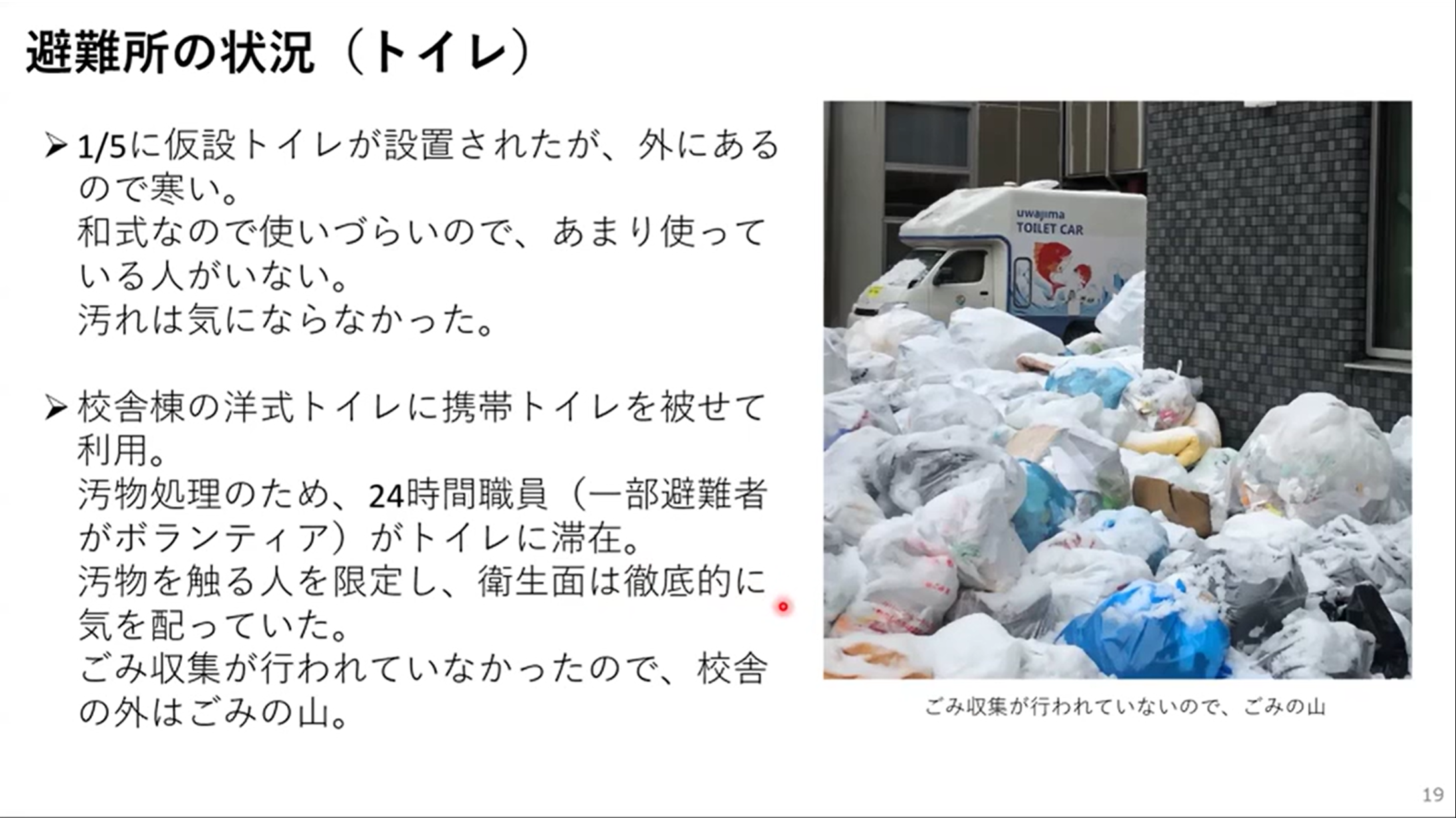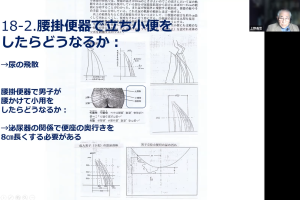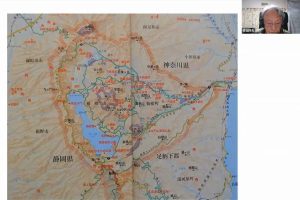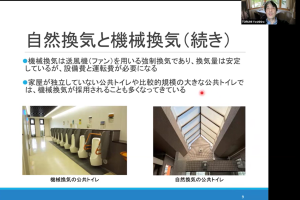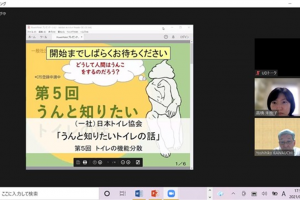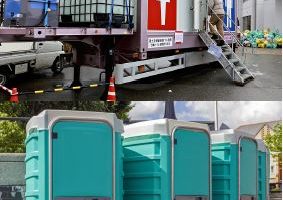The 32nd seminar
“Urgent Report on the catastrophic Noto Peninsula Earthquake on the new year day of 2024”Japan Toilet Association (JTA) Seminar Series; “Let us know more about our Toilet Story”
Date: 15 February 2024 (Thu) 18:00-20:00 JST
Presenters:
Lecturer/Reporter 1; Dr. Mikiko Takahashi (Director of JTA, Manager of R&D Division of Company Inc.)
“The urgent report of the catastrophic Noto Peninsula Earthquake”
Lecturer/Reporter 2; Mr. Tomonori Tanaka (JTA Steering Committee Member, Nippo Setsubi Co., Ltd. Representative Director)
“Toilet and water supply in Wajima city”
Lecturer/Reporter 3; Mr. Taro Tora (JTA Steering Committee Member, Secretary-General of the Disaster and Temporary Toilet Study Group in JTA)
“Toilet at the catastrophic disaster”
Lecturer/Reporter 4; Mr. Ken Nishimura (Corporate member of JTA, Member of Disaster and Temporary Toilet Study Group in JTA, Sogo service Co., Ltd.)
“Portable Toilet Support at the catastrophic Noto Peninsula Earthquake in 2024”
(1) An urgent report of the catastrophic Noto Peninsula Earthquake
Presenter; Dr. Mikiko Takahashi
The catastrophic Noto Peninsula Earthquake occurred on 1st January 2024. I will talk about the damages at Noto Peninsula in Ishikawa Prefecture in Japan. Next, I will introduce about the situation on 7th and 8th January when I joined the urgent kitchen service at Wajima Junior High School which was used as an evacuation centre then. Lastly, I will talk about the situation when I volunteered to clean up Bed and Breakfast (B&B) and private houses on Notojima island in Nanao city from 18th January.
Ishikawa Prefecture is long shape from north to south. Our company is located at Komatsu city in the southern end location. Wajima city is located on the north end of Noto Peninsula. It suffered from the most damage this time. Wajima city is about 130 km away, and Suzu city about 170 km away from our place, Komatsu city. Kanazawa city is about 30 km north from Komatsu city which is the prefectural capital, and Uchinada Town is about 10 km further north.
(1.1) Overall view of the damages in Ishikawa Prefecture
Our company is in Komatsu city, which is more than 100 kilometers away from the epicenter. Even here, many documents fell from the shelves and were scattered on the floor. The shelves themselves were fortunately fixed so they did not fall over.
The water was cut off until 8th January and all the toilets and water were usable now. The lifts have stopped until 18th January. There are still areas in the company building that are off-limits even in mid-February. There is a limited areas affected in both Komatsu city and Kanazawa city. The people there are now fortunate to spend their daily lives without any serious problems.
Uchinada town, located about 10 kilometers north of Kanazawa city, is still no water service due to the liquefaction of the ground. A big fire broke out in the middle of Wajima city. There were so many collapsed buildings in Wajima and Suzu city that it seemed normal for them to collapse ironically. Roads leading to Wajima and Suzu city were also severely damaged. Originally, there were few roads leading to the Noto Peninsula region, but those limited roads have cracked and been cut off, and their accessible ways are still restricted. It usually takes about two and a half hours to reach from Kanazawa city to Wajima city. It took more than 12 hours to reach before the traffic restrictions were imposed after the disaster.
(1.2) Wajima Junior High School
I went to an urgent kitchen service at Wajima Junior High School on 7th and 8the January, when is one week after the earthquakes. About 1,000 people were evacuated there at that time, which was the largest evacuation centre in Wajima city. The school building was newly built in 2018, and all the toilets were installed the sitting style ones, which were quite relief in such an earthquake disaster. The electricity has been recovered from 4th January, but I think the water supply is still cut off.
A large amount of the supply goods had delivered to Nanao city and Anamizu town, but Wajima city is located a little further north, and the roads are still in hard condition. There are still lack of many supplies. After items arrive once at the supply base centre in Wajima city and they are delivered to each local evacuation centre. However, the needs of each centre are not fully recognized and the shortage of the manpower to deliver them. Sometimes the supply goods could not cover all needs.
The supplies were delivered at Wajima Junior High School. However, the city staffs in the evacuation centre were too busy to sort them. They were just left to pile up eventually. It was a quite confusing situation and the staffs could not find where it was. The drinking water and kerosene bottled in the same style and colour containers. Many stoves became unusable because they were supplied the water instead of the kerosene. The necessary goods were announced on TV, and large quantities of the drinking water, diapers, sanitary products, handy toilets, and disposable hand warmers were delivered.
A large amount of the diapers for babies were delivered, although there gathered many high aging people instead of the babies in Wajima city. The necessary goods are quite shifting depending on the evacuation centres and the elapsed time. The exact information about what is necessary at the temporary evacuation centre was not being conveyed precisely.
I asked to the people what was urgently necessary at Wajima Junior High School. They replied the necessary goods were the shorts and trousers. There were many elderly people and the toilet situation was worst. I felt sorry that some old people have no choice but to incontinent after they have tried to hold their urination.
Some old people soiled their underwear, and they wore the diapers instead of the shorts, even though they have not usually used them. One old lady was wrapped in a blanket with the diaper because she could not have the trousers to change. There was truly a high demand for the shorts because they couldn’t take a bath. The vaginal discharge sheets were welcomed by many women in such situations where women were unable to change their underwear or take a bath.
Approximately 1,000 people evacuated at Wajima Junior High School. However, only 150 rice balls were delivered for dinner on the night of my first visit on 7th January. It was not enough at all, of course. Fortunately, the electricity was supplied and we had some rice in stock. We cooked the stored rice with the pre-cooked retort curry. The cassette gas stove was quite useful on the spot.
The meals were not delivered the next morning. 450 rice balls were delivered at lunch time, which were not enough, and all of them were past the best-before dates. It was quite cold weather, and a cup noodle was very welcome as a warm meal. However, they were getting tired of them after a week since they all taste the same. Some people suffered from the constipation due to lack of the vegetables, while others suffered from the diarrhea after taking the laxatives. We received plenty of drinking water, but there were occasional requests for the juice for change.
I visited Nanao evacuation centre on 6th January. There was a request for a private space. Our company produces a partition, and we carried them to the evacuation centre. The people in Wajima are primarily focused on living and eating. We asked there about requests for the partitions to improve QOL at the evacuation centre, but we have hardly heard of any requests of it. However, a cardboard cabin developed by a professor of Nagoya Institute of Technology was delivered to Wajima Junior High School and used as a changing space particularly for the women.
The evacuees were sleeping directly on the hard floors of school classrooms and gymnasiums, but the floors were cold and solid. Then the cardboard boxes of the relieve goods were very helpful. They slept with the cardboard spread out on the floor and several blankets piled up to soften the touch. There were no chairs or beds and the elderly people annoyed to stand up.
I went there from the night on 7th January. Many evacuates began to feel sick with the diarrhea or vomiting, and 5 patients were carried by the ambulance in the night. The hospital was full of the patients. They asked to return after they were given only intravenous drips, and they were vomiting again. This situation worsened on the 8th. The disposals of the vomits were restricted to process by Wajima city staffs only, because there was severe concern about the infection. As a result, city officials were too occupied with disposing of them.
An isolation room was assigned to only those who were not feeling well on 7th January. However, the infected people had rapidly increased to be full out of the room by 8th January. A medical team came and set up an isolation floor prohibited from wearing shoes on the third floor of the school building. There are infected patients at the evacuation centres in any disaster, then I thought the supplies for the infection disease control and the medicines against the infection disease were also essential. The evacuation centre was managed by about only six Wajima city
staffs on the rotating basis, but as these staffs themselves were also the disaster victims. There was totally lack of manpower to manage the whole evacuation centre.
I thought it is necessary a system to send in people from outside to help to manage the evacuation centre at the very beginning. Wajima city staffs could not have time to eat and were running around with biting only chocolate or snacks. After I returned on the 9th, I heard that other local government support staffs joined to help the management of the evacuation centre.
(1.3) The toilets in Wajima Junior High School
The temporary toilets were already installed at Wajima Junior High School from 5th January. However, it was cold to use in the outdoors, and difficult for the elderly people to use for its crouching style, and did not many people use them consequently.
I found that those temporary toilets were not always dirty, when I observed inside. All the toilets in the school building were the sitting style ones, and people used the handy toilet which is a disposable plastic bag toilet by fitting in. The volunteers or evacuees accompanied there 24 hours a day and instruct how to use the handy toilet or process the waste. The number of infected people continued to increase within one week after the earthquakes although thorough hygiene measures were taken and restricted the number of people who touched the filth.
The handy toilets are disposed after use. At that time, there was no garbage collection services, so the area outside the school building was full of the used handy toilets and household garbage. A toilet on the lorry arrived from Uwajima city on 7th January. There was a lift on the deck of the lorry for the users. This was highly accepted by the elderly and people using a walker aid or cane. There was allocated a staff who explained how to use the lift during the day time, but the staff will leave at the night and there were problems how to operate and manage it then.
(1.4) The situation on Notojima Island
We, the staffs of Comany Inc. went to clean up B&B and private houses in Notojima Island with a volunteer group called NPO United Earth from 18th January. Notojima is an island on the east of Nanao city and there are two bridges to connect with Noto Peninsula. One of them is still closed and we can only pass the other one bridge now. Not enough water or meals were delivered to Notojima Island although many goods were stored in the centre of Nanao city. Notojima Island suffered much less damage than Wajima city or Suzu city, but there were some places where houses collapsed.
The Noto Peninsula experienced a large earthquake with a seismic intensity of 6+ in 2007. A house we helped to clean up was once knocked down the furnitures and scattered household items at the former 2007 earthquake. An elderly person living alone there, and he was unable to clean up the mess by himself only, so he continued to live as he was. They were happened following earthquake with a seismic intensity of 6+ in May 2023. This caused even more clutter. The situation was even more chaotic due to this recent magnitude 7 earthquake. There are many elderly people living in Notojima Island, and those are having quite a hard time. They are difficult to go to the shops alone or there are no one to carry their purchased heavy items.
They can receive a lot of information from Nanao city if they have registered LINE service. However, many people do not use the smartphones and they cannot receive this kind of the information. They cannot know where to ask for volunteers to clean up. A resident lived in crumbling houses with bulging floors, collapsed walls, and parts of the ceilings which were falling where I went to help. The water service is still cut off on Notojima Island, and it is said that it cannot be restored until April.
(1.5) Summary
– There are limitations to manage the whole evacuation centre with only a several city staffs who are also the victims of the disaster. It is necessary to be managed with outside supports.
– There found also large disparities between evacuation centres. I think it would be ideal if the information on needs could be consolidated and then shared.
– It is difficult for the supplies to reach people who are living in their homes, cars, or other places other than the those in the evacuation centres.
– The roads were so seriously damaged that it was scary to drive in some places.
– The life is extremely difficult when water is cut off.
– I went there for only 2 nights and 3 days, but I was worried about using the toilet and would not drink enough water. I was always hungry because I tried to refrain from eating. Even after just a few days of my experience, I felt my demands such like “I want to wash my hands with simply running water,” “I want to drink much water,” and “I want to eat enough of meals.”
– The items that are currently in short in the disaster areas are: toilet papers, drinking waters, drinks other than water, packaged rice, accompaniment to the rice, cups of miso soup, paper cups and plates, chopsticks, food wraps, toothpastes, body creams, etc.
(2) Toilet and water supply in Wajima city”
Presenter; Mr. Tomonori Tanaka
(2.1)
I am a representative of Nippon Setsubi Co., Ltd., who handles the water supply, discharge, and air conditioning work. During the catastrophic East Japan Earthquake in 2011, I went there as a technical volunteer. Since then, I have continued to provide a volunteer support to the areas affected by the earthquakes or typhoons such at Kumamoto and Chiba prefectures. Whenever we go to the place, we organize a group called “Nippo Setsubi Disaster Support Team.” At first, I went there alone as an observer for three days and two nights during 13th to 15th January to investigate the site situation. It unfortunately snowed hard on 14th.
I returned to Tokyo on 16th January, Monday and ordered the necessary materials and tools. At the same time, I recruited members to go to the disaster area, and the first team of four people went to there from the 19th to the 22nd. The second team with 8 people went from February 2nd to 4th. It was easier to get there because I have a car with the studdles tires that can withstand rough roads. It is a plug-in hybrid car that can generate enough electricity to run even an air condition machine.
Many collapsed buildings were blocking roads to pass in some areas near to Wajima city centre even on 3 February, when is more than a month after the earthquake. Usually, the owner’s consent is required to clean up the collapsed buildings. It is not easy to use a machine to clean them all at once, since there are many memorabilia left behind. Meanwhile, the road has been gradually restored. It took about nine hours to get there on 13 January for the first team, but the second team reached in eight hours. I covered about 1.5 million yen in total for the materials, transportation, household goods, etc.
I brought an agricultural tank that can hold 1,000 liters of the water and a household pump. The pump can be powered by a regular 100 voltage outlet or by a mobile battery. It can be used this pump to supply the water after storing it in the tank.
(2.2) A construction example at a group home for the people with disabilities
After filled a tank with water, it connected to an outdoor faucet, and then used a pump to send water into the building to supply the water. The toilet flush can be spontaneously used as well. There fortunately supplied the electricity already, and they could use hot water.
The gymnasium of Kawai Elementary School, located right next to Wajima city hall, has been used as an evacuation centre. The water in the pool was applied to flush of the toilets. A mobile battery was used to run the pump to supply water to the toilet as the electric power outage still there. A faucet for toilet cleaning was newly set.
There are advantage and disadvantage to combining the agricultural tanks and the household pumps. The advantage is that they are light wight and their installation is relatively easy. The disadvantage is that the pump costs about 100,000 yen. It is expensive particularly when multiple ones necessary, and it is no use unless there is a water to fill the tank. The water is supplied by the water tankers in some areas where water may be difficult to obtain. It cannot be used when the water supply piping inside of the building is broken. We sometimes install the other pipes to make it usable again when some parts are already broken. Furthermore, it cannot use there when the drain pipe is also broken.
(2.3) Summary
When we slept in a car, it was too cold to wear just a sleeping bag. We could sleep quite comfortably without starting the car engine when an electric warm blanket connected to the mobile battery. Since I hate to go outside to go to the toilet, I ended up drinking less water. The outdoor temporary toilets do not have the lighting. Then a headlamp is helpful that allows to use both hands. I gradually depressed both physically and mentally as we cannot take a warm bath. The cassette gas stoves are quite convenient and useful to eat hot meals there.
(3) Toilets at the catastrophic disaster
Presenter; Mr. Taro Tora
I am a Secretary-General of Disaster and Temporary Toilet Study Group in JTA. We exchange information on the disaster responses with Ministry of Economy, Trade and Industry (METI) on a daily basis. We share this with our members and other organizations. We liaise with METI when a catastrophic disaster occurs. JTA is not a manufacturer group, but when it happens then METI orders directly to the member companies and communicates each other, and they will ship soon the order goods where prepared. A mailing list has been prepared, and in case of an emergency, METI will broadly contact all related companies with a single e-mail.
A document by Ministry of Land, Infrastructure, Transport and Tourism (MLIT) describes that the manhole toilets were prepared about one day after the disaster, and temporary toilets began to be deployed from the third day onwards of the earthquakes. It is necessary to stock up on the handy toilets and the portable toilets on the daily basis as it is not possible to cover total toilet needs. Japan Toilet Research Institute reported that the temporary toilets were delivered to about 50% of the locations at the catastrophic East Japan Earthquake within four to seven days after the earthquake.
The Noto Peninsula catastrophic earthquake occurred on 1st January. “Company A” was the quickest to respond the requests of the push-type support from METI, and the company shipped 30,000 portable toilets by the next night of the 2nd January. The other companies followed and 470,000 portable toilets had already been delivered to the local evacuate centres by the 8th January.
All companies who produce of the temporary toilets were closed for the New Year days. The stocks were to be shipped from near Ishikawa Prefecture and neighboring prefectures before from all over Japan. 331 toilets which were mostly crouching style ones to use at the construction sites, had been shipped by the 8th.
(4) The handy Toilets supply at Noto Peninsula Catastrophic Earthquake 2024
Presenter; Mr. Ken Nishimura
(4.1) Overview
This Noto Peninsula catastrophic earthquake happened at 4:10 pm on 1st January. At 5:51 pm a single e-mail from METI was sent to the JTA secretariat and the manufacturer members inquiring about the possibility of the disaster support. At 10:42 pm, we received a following e-mail from METI requesting for the procurement of the disaster toilets may be made after 2nd January.
The next day, on the 2nd January, we received an e-mail from METI inquiring about the available lorries for transporting the toilets. Moreover, there was a request for a sudden response. While business activities were suspended on the second day of New Year, I reluctantly surveyed number of the vehicles and the portable toilets that could be shipped and replied to METI by e-mail. Immediately after that, I received a direct phone call from the manager of METI. He said the government will announce that it would provide strong “Push type support by the government” to the disaster area at this earthquake.
At 12:30 pm on the 2nd January, I received an e-mail informing me that the push-type support had been confirmed and asking me to deliver the portable toilets to the Industrial Exhibition Hall in Kanazawa city. Our company is based in Tokyo, but our factory is in Fuji city, Shizuoka Prefecture. The lorry is to depart from there to Kanazawa. The lorry drivers are now forced to take at least a 30 minutes break when they drive for more than four hours by the law. The lorry started from our factory at 3:00 pm on 2nd January and it was arrived at the Kanazawa Industrial Exhibition Hall where is 450 kilometers away, at 9:40 pm on the day. I heard that they were transported them by a car from the Hall to the Self-Defense Force in Komatsu air base. At 10:30 p.m., they were then transported by a helicopter to Wajima city and Suzu city from the air base.
On the morning of 4th January, we received a following request for the additional handy toilets from METI. The loaded lorry left the factory at 6pm. This time, we delivered it to the same Hall as before and completed the delivery at 0:15 am in the midnight next day.
Although I personally could not visit Wajima city and Suzu city, where the damages were most severe, I visited several locations, Nanao city and Shiga Town. I instructed how to use the handy toilets. One evacuation centre displayed a model of the handy toilet attached to an actual toilet bowl to make it easier to recognize how to use it.
(4.2) Issues for the future action
(4.2.1) The damage in the area where the catastrophic earthquakes are not predicted
These area people have not predicted of the exceeded earthquakes. Because of this reason, the inhabitants did not sufficiently care of the disaster prevention and preventive measures were not well taken. As a result, the support activities could not go smoothly.
METI seemed to have assumed that prefectures and local governments would send what they needed as push-type support, but they did not know actually what they were necessary. METI assumed that push-type support would start a few days after the disaster, but self-support and mutual-support system could not function well soon after the disaster areas. We believe to encourage activities of self-support and mutual-support immediately after a disaster would be absolutely necessary.
(4.2.2) The limitation of the speedy support to the disaster area
The roads are the main route for the transporting goods. When it is unusable, the only option is a detour. It becomes impossible to rely on the car navigation tool. This hinders smooth support since the lorry drivers are deeply relying on it.
(4.2.3) The work style improvement law for the lorry drivers in 2024; the issues for the long-distance transportation conditions
Some companies once opened even during New Year days. Nowadays they are closed due to the work style improvement. I heard METI could not contact many companies during these days when this catastrophic earthquake occurred. Even if there were supply goods and lorries to carry, there were problems of the driver shortage. Even if there was a driver, the carrying lorry was not available. The drivers also had to take breaks after long drives. Because of this, the delivery time will be delayed eventually.
(4.2.4) The problem of low stocking rate of the handy and portable toilets on the spot
The Disaster and Temporary Toilet Study Group in JTA surveys on the stockpiling rate of the handy and portable toilets in households every three years since 2017. The rate is gradually increasing that15.5% in 2017, 19.5% in 2020, and 22.2% in 2023. However, the stockpiling rate shall still be not enough. On the other hand, the stockpiling rate for meals and drinks is about 50%. Then the stockpiling rate for the handy and portable toilets is only about half of them eventually.
This Study Group is working with METI and JTA to promote the stockpile of the handy toilets. It takes time for the public-support to reach. It is necessary to increase the stocking rate of the portable toilets for self-support and mutual-support for preparing the immediate supports after a disaster.
(Kawauchi) One person normally goes to the toilet about five times per a day. In calculation, 35 portable toilet packages are necessary for one week. 140 packages are for a family of four people.
4. Q&A
(Q1: Kawauchi) Did you charge the mobile battery from the car?
(A1: Tanaka) My car can charge it. The electricity in Wajima city has been restored in many places, then we can also charge the batteries from the electrical outlets of the houses. It can also be charged from the solar panels.
(Q2: OS) What was the status of the sewage repairment?
(A2: Tanaka) Many places where the sewage could be used provided the buildings were not shifted. According to my impression, the sewages were functioned in many places except the places where the ground had liquefied and the manholes were shifting up.
Some small villages had the septic tanks installed for their own use, but when the pipes connected to these tanks were broken and they were almost unusable.
As for the water supply, it had been made earthquake resistant, and the main pipes installed on the road were of quite stable quality. The pipes to connect into each house from there were old and broken in many places. The local government officials and their contractors who had come from outside to assist digging up and repaired each piece one by one. It seemed that water outages in Wajima city were being resolved at a considerable pace.
(Q3: HO) I heard that the government will take a push-type support spontaneously, sending aid even if there is no request from the local government. What is the actual situation at this time?
(A3: Tanaka) I found there were many Self-Defense Forces, fire department personnel, police officers, and medical staffs. Despite there were many rescue staffs, there were still many places where the work was slow in progress, such as a collapsed house blocked the front road that could not be easily cleaned up without the consent of the homeowners by the law.
(Q4: HO) I would like to know the procedure for push-type support by the government.
(A4: Nishimura) METI had surveyed of the volumes that the manufacturers can supply under the agreements. The manufactures inform to METI of the quantity and prices they can supply at the emergency time in advance. We receive inquiries based on the data about whether we can ship at the disaster.
(C5: Kawauchi) The fact that many handy toilets are being sent to disaster areas means that many used handy toilets become as wastes there. I’ve heard that the water-absorbing polymer of the handy toilet may turn back into the liquid depending on the quality of the polymer, or that gas can be generated by the stool, and the bag may burst.
(A5: Tora) Sogo Service Company’s handy toilet combines with a liquid absorb pad like the diapers inside the plastic bag. This pad works well and it takes time to turn itself back into a liquid, and it doesn’t leak easily. The plastic bags will last about 10 years in terms of deterioration.
Some cheap products are sold by online, but even if you stock up on them, the bag may deteriorate and become unusable by the time when time of the the actual use. The study group would also like to implement technical aspects such as proposing product standards.
Furthermore, big problems occur at the time of the garbage collection, if general garbage and filth are not separated. The top issue is the separation of the garbage. JTA will create a disaster manual.
(C6: Kawauchi) Dr. Mikiko Takahashi told there were many people who were vomiting, and there are concerns about the infectious diseases. I have heard that when collecting the used handy toilets and if the bag is crushed, the waste will scatter and spread infection to the collecting staff. The sorting garbage is quite essential way indeed.
(C7: Tora) There are varieties of the toilets that are useful in the emergencies. They are handy toilets, portable toilets, manhole toilets, temporary toilets, toilet cars, and trailer toilets. The handy toilet does not have toilet seats. It is designed with the assumption that it will be used with a toilet bowl, a chair, or somewhere else to sit. The seat of the portable toilet is made of the cardboard, plastic, or something like a folding chair, and it is usually folded into a small size and stored. It is appropriate to stock the handy toilets as the toilet seat can be used in the house. In evacuation centres, there may only be the crouching style toilets, so I think it would be easier to use a portable toilet which combines the seat.
The manhole toilets will be installed by the local governments. When a disaster occurred, a toilet bowl and enclosure can be assembled and used on top of a manhole on the ground. The thin pipes in ordinary manholes may fill up soon. Then many places install special manholes for the manhole toilets with the underground facilities.
The temporary toilets are often placed at the construction sites. Ministry of Land, Infrastructure, Transport and Tourism (MLIT) recommends “The Comfort Toilets” which are spacious and comfortable. Many of the toilets at the construction sites are traditional crouching style toilets, which are hard to use for the elderly people or people with disabilities at the disaster areas. Many people request about the necessity of the sitting style toilets and wheelchair accessible ones. There are also the toilet cars, where a toilet is installed in the cargo bed of the lorry. There is also a towable trailer toilet. These styles of the vehicles are now kept at more than 20 cities, towns, and villages in Japan. A dedicated network has been established to dispatch the vehicles to the disaster area.
However, it takes several days for the municipality that owns the trailer toilet to decide to dispatch it to the site. Once the decision is made, it takes a few days to arrive. Currently, 74% of the temporary toilets provided by the rental companies are the crouching style ones. The sitting styles are only 26%. Therefore, the crouching style is the only way to get it at an initial stage. The manufacturers now make about half of the toilets that are the comfortable toilets, but the majority are still the crouching style ones.
When there are only the crouching style toilets of the temporary toilets at an event venue, I would like everyone to raise your requests and ask for the necessity of the sitting style toilets. I would also like to be heard the requests that the necessity of the sitting style toilets at the evacuation centres. I will convey the various requests from everyone to the ministry.


